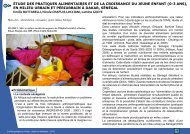L'anthropologie du vivant : objets et méthodes - CNRS - Dynamique ...
L'anthropologie du vivant : objets et méthodes - CNRS - Dynamique ...
L'anthropologie du vivant : objets et méthodes - CNRS - Dynamique ...
- No tags were found...
You also want an ePaper? Increase the reach of your titles
YUMPU automatically turns print PDFs into web optimized ePapers that Google loves.
Surpoids <strong>et</strong> obésité : une norme bio médicale unique en questionC<strong>et</strong>te « typologie » des indivi<strong>du</strong>s se révèle insatisfaisante car elleparaît rigide <strong>et</strong> fixiste, ignorant toutes les dimensions culturelles <strong>et</strong>comportementales in<strong>du</strong>ites par la notion de population. La variable «population géographique » n’est pas en eff<strong>et</strong> informative car elle englobeun pool de facteurs éco-sociaux très différents d’une région à l’autre : lesenvironnements physiques (climat ou niveau d’urbanisation) diffèrent,les comportements alimentaires varient (en termes d’apports caloriquesjournaliers, d’aliments de base ou de mode de préparation par exemple),le niveau d’activité physique <strong>et</strong> les dépenses énergétiques sont différents,les contextes socio-économiques, politiques <strong>et</strong> religieux sont divers.Une approche davantage holistique de la variabilité inter populationnelleparaît nécessaire car c<strong>et</strong>te dernière résulte de l’interaction entre descaractères intrinsèques <strong>et</strong> un large éventail de facteurs extrinsèques.L’indivi<strong>du</strong> ne peut pas être résumé à un assemblage de liaisons simples,il est le résultat d’un « processus » caractérisé par un grand nombre devariables aléatoires (Guerci <strong>et</strong> al. 2007).Enfin, le choix entre une norme identique pour tous ou un standardspécifique à chaque population est une problématique communeà tous les champs de recherche qui s’appuient sur la mesure <strong>du</strong>corps. C<strong>et</strong>te question est par exemple particulièrement aigüe dansle domaine de la croissance. Référentiels locaux <strong>et</strong> internationauxcoexistent <strong>et</strong> finalement se complètent au quotidien : les référentielsinternationaux de l’OMS perm<strong>et</strong>tent de standardiser les études <strong>et</strong>de comparer les modalités de croissance entre populations, lesstandards locaux semblent quant à eux plus appropriés poursuivre la croissance <strong>et</strong> évaluer l’état de santé d’un indivi<strong>du</strong>dans un contexte clinique quotidien.Il reste dans tous les cas nécessaire de rester attentif lors dela sélection <strong>du</strong> modèle normatif auquel nous nous référonscar ce choix influencera à terme les politiques de santé <strong>et</strong>de prévention, ainsi que les moyens financiers engagés.Références bibliographiquesBASDEVANT (A.) 2004, Définitions <strong>et</strong> classifications des obésités,in A. Basdevant <strong>et</strong> B. Guy-Grand (éd.), Médecine de l’obésité,Flammarion, Paris, p. 3-7.CHANG (C.J.), WU (C.H.), CHANG (C.S.), YAO (W.J), YANG (Y.C.),WU (J.S.), LU (F.H.) 2003, Low body mass index but high percentbody fat in Taiwanese subjects: implications of obesity cutoffs,International Journal of Obesity and Related M<strong>et</strong>abolic Disorders 27(2): 253-259.CHO (V.) 2002, WHO reassesses appropriate body-mass index forasian populations, The Lanc<strong>et</strong> 360: 235.CRAIG (P.), HALAVATAU (V.), COMINO (E.), CATERSON (I.) 2001,Differences in body composition b<strong>et</strong>ween Tongans and Australians:time to r<strong>et</strong>hink the healthy weight ranges?, International journal ofobesity 25: 1806-1814.DEURENBERG (P.), WOLDE-GEBRIEL (Z.), SCHOUTEN (F.J.M.)1995, The validity of predicted total body water and extra-cellularwater using multi-frequency bioelectrical impedance in an EthiopanPopulation, Annals of Nutrition and M<strong>et</strong>abolism 63: 4-14.DEURENBERG (P.), YAP (M.), VAN STAVEREN (W.A.) 1998, Bodymass index and percent body fat: a m<strong>et</strong>a analysis among different<strong>et</strong>hnic group, International Journal of Obesity and Related M<strong>et</strong>abolicDisorders 22 (12): 1164-1171.DEURENBERG-YAP (M.), SCHMIDT (G.), VAN STAVEREN (W.A.),DEURENBERG (P.) 2000, The paradox of low body mass index andhigh body fat percentage among Chinese, Malays and Indians inSingapore, International Journal of Obesity and Related M<strong>et</strong>abolicDisorders 24 (8): 1011-1017.GALLAGHER (D.), HEYMSFIELD (S.B.), HEO (M.), JEBB (S.A.),MURGATROYD (P.R.), SAKAMOTO (Y.) 2000, Healthy percentagebody fat ranges: an approach for developing guidelines based onbody mass index, American Journal of Clinical Nutrition 72: 694-701.L’anthropologie <strong>du</strong> <strong>vivant</strong> : <strong>obj<strong>et</strong>s</strong> <strong>et</strong> méthodes - 201050











